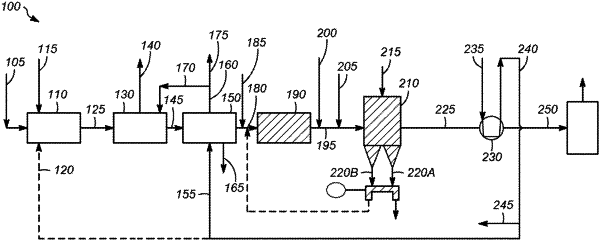| CPC C10G 11/185 (2013.01) [F01N 3/2066 (2013.01); C10G 2300/207 (2013.01)] | 20 Claims |

|
1. A method for treating flue gas from a fluid catalytic cracking (FCC) unit catalyst regenerator, an FCC unit catalyst regenerator CO-combustor, or a dehydrogenation unit catalyst regenerator comprising:
transferring heat from flue gas stream from the FCC unit catalyst regenerator, the FCC unit catalyst regenerator CO-combustor, or the dehydrogenation reactor to a boiler feed water stream in a heat recovery steam generator (HRSG) to form a cooled flue gas stream and a steam stream, wherein the flue gas stream comprises one or more of sulfur-containing compounds, nitrogen-containing compounds, and catalyst fines and wherein the flue gas stream has a temperature in a range of 200° C. to 290° C., the temperature being above a dew point of water and an acid comprising sulfuric acid and/or sulfur trioxide;
reacting one or more of the sulfur-containing compounds, the nitrogen-containing compounds, or both in the cooled flue gas stream from the HRSG with a reactant in a decontamination reactor, wherein the reactant comprises one or more of NaHCO3, NaOH, KOH to form a reactor effluent stream comprising one or more of Na2SO4, NaNO3, NaNO2, Na2CO3, K2SO4, and KNO3 while maintaining the reactor effluent stream at a temperature in a range of 200° C. to 290° C.;
filtering the reactor effluent stream to remove at least one of the Na2SO4, NaNO3, NaNO2, Na2CO3, K2SO4, KNO3 and the catalyst fines and form a filtered reactor effluent stream; and
pre-heating a combustion air stream or the boiler feed water stream with the filtered reactor effluent stream thereby reducing the temperature to 130° C. to 200° C. and staying above the dew point of water.
|